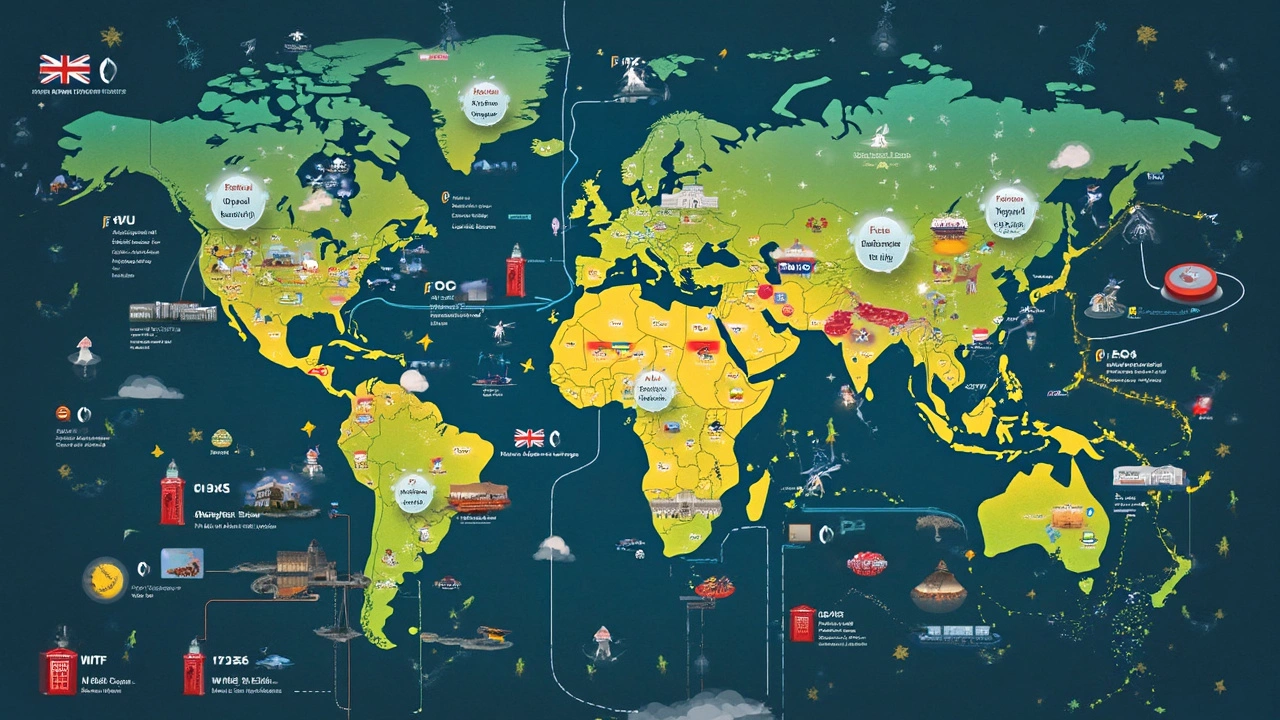Tennis Competition Hierarchy: How Tournaments Stack Up

Tennis tournaments aren't just random events thrown together—there’s a real system to it all. If you’ve ever wondered why some trophies seem like a way bigger deal than others, you’re not alone. The way tournaments are ranked affects everything: how much prize money players take home, how many ranking points they score, and honestly, how much bragging rights they get among other players.
A beginner might see a tournament on TV and think, 'Why isn’t this one like Wimbledon?' It usually comes down to history, prestige, and the level of players it attracts. Some events feel like grand parties with full stadiums, while others are quiet, with newbies fighting hard for every point. Knowing this hierarchy isn’t just for superfans or pros—it helps if you want to follow players, bet smart, or maybe even start competing yourself one day.
- From Local Courts to the Pro Circuit
- ITF, Challenger, and Junior: The Starting Blocks
- The Rise: ATP, WTA, and Premier Tournaments
- The Peak: Grand Slams and Year-End Finals
From Local Courts to the Pro Circuit
Every big name in tennis starts out small. Think about it—the sport isn’t just about Center Court at Wimbledon. For most players, it begins in local club tournaments or city leagues. These events are super grassroots, usually run by community clubs or regional organizations. They rarely offer prize money, but they build skills and confidence. You’ll find all ages competing, and sometimes, you’ll spot future pros getting their first taste of competition.
Once players start winning local and regional matches, they move up to higher-stakes contests: national tournaments. Every country has its own tennis body. For example, the USTA runs key U.S. events, while the LTA oversees British tennis. Doing well at these tournaments is a must for teens who want college scholarships or hope to play full-time. These events hand out ranking points—think of it as a scoreboard showing who’s the most promising.
But how do you get from a city court to playing on TV? Here’s the basic ladder:
- Local and regional tournaments: Entry is usually open, and sometimes you just pay a small fee.
- National tournaments: You’ll need decent results to qualify. These can be age-group or open levels.
- ITF (International Tennis Federation) events: The real launchpad to becoming a pro. Players collect world ranking points here.
Competition gets serious at the ITF level. Events are hosted worldwide, and prize money—while still modest compared to the big leagues—covers basics. Most pro players grind through this stage for years, playing in places most fans have never heard of. Fun fact: in 2023, there were over 550 ITF World Tennis Tour events in over 80 countries, showing just how global this initial stage is.
| Level | Typical Prize Money | Ranking Points | Examples |
|---|---|---|---|
| Local/Regional | None–Low | Club/National only | City open, state juniors |
| National | $100–$1,000 | National | USTA National Championships |
| ITF | $15,000–$100,000 | ITF/ATP/WTA introductory | ITF World Tennis Tour |
The system can feel overwhelming, but advancing is all about racking up wins and collecting points. That’s what turns weekend warriors into real contenders aiming for a spot in the big leagues. And remember, for every pro you see on TV, there are thousands more grinding away at these lower rungs.
If you’re considering playing or following a friend in this journey, keep track of points, watch out for those key ITF events, and don’t underestimate a minor-looking match—it might just be the start of a career.
ITF, Challenger, and Junior: The Starting Blocks
If we’re talking about the tennis tournament levels where careers really kick off, it starts with the ITF, Challenger, and junior circuits. These aren’t glamorous, but they matter big time if you want to climb the tennis ladder.
The ITF (International Tennis Federation) World Tennis Tour acts as a launchpad for newcomers and players aiming for professional status. These tournaments come with smaller prize pots—usually between $15,000 and $100,000—and fewer ranking points compared to the higher-ranked events. If you see a player grinding in an ITF event, they’re often trying to break through or bounce back from injuries.
Next up: the Challenger Tour. Think of it like the basketball G-League or minor league baseball. It sits just below the ATP and WTA Tours and serves as a bridge for players hoping to crack the big leagues. You’ll see players ranked from about 50 to 500 competing here, fighting for more ranking points and a shot at main-draw entries for bigger tournaments. Challenger events are usually all-business—less media, more hustle, and a bunch of hungry players fighting to make it.
Then there’s the junior circuit, which is run by the ITF for players under 18. Top juniors win spots in Grand Slam junior draws, and plenty of today’s stars—like Carlos Alcaraz and Iga Swiatek—cut their teeth in this environment. Good results here can earn wild cards into pro events, so it’s not just about trophies: it opens real doors.
Here’s how the basics stack up:
| Level | Typical Prize Money | Ranking Points (Winner) | Approx. Player Ranking |
|---|---|---|---|
| Junior | Non-cash Prizes | ITF Junior Points | Under 18 |
| ITF World Tennis Tour | $15,000 - $100,000 | 10-125 | 600-1000+ |
| ATP/WTA Challenger | $40,000 - $220,000 | 50-125 | 50-500 |
A quick tip: If you have your eyes on a particular pro, track their progress through these smaller tournaments. They might fly under the radar now, but this is where those surprise Grand Slam breakouts build their game and confidence.

The Rise: ATP, WTA, and Premier Tournaments
After breaking through the lower levels, players set their sights on the real heavy hitters: ATP and WTA tournaments. These are the backbone of pro tennis. They offer the kind of ranking points, prize money, and global attention that can totally change a player's career.
The men's circuit is run by the ATP (Association of Tennis Professionals). It's structured in tiers, each with its own flavor and level of competition:
- ATP Masters 1000 events are just a notch below the Grand Slams. Think huge crowds, big-name stars, and a ton of points up for grabs. Players who crush it here can rocket into the world’s top 10.
- ATP 500 and ATP 250 tournaments offer fewer points and cash than the Masters, but they’re still stacked with high-level talent. You’ll see top-20 players mixed with hungry journeymen and rising stars.
The women's side works a bit differently. The WTA (Women's Tennis Association) splits tournaments into:
- WTA 1000: These are the women’s version of the Masters. Punchy lineups, headline matches, and big media buzz.
- WTA 500 and WTA 250: Still important, especially for those working up the ladder or trying to stay relevant in the rankings.
Back in 2023, the prize pool for Indian Wells (an ATP Masters 1000 and WTA 1000 event) was just over $17 million—more than most people will ever see in their bank accounts. No wonder players go all out here.
Here’s how the ranking points break down for the main events at this level:
| Event | Winner's Points |
|---|---|
| ATP Masters 1000/WTA 1000 | 1000 |
| ATP 500/WTA 500 | 500 |
| ATP 250/WTA 250 | 250 |
One thing to know: players have to play a mix of these events to move up the rankings. It’s why you see top names bouncing from city to city on the global tennis tour, racking up miles, points, and hopefully, trophies. This is really where a solid run can sling a player from no-name status to tennis stardom. If you’re scouting for the next big star—these are the tournaments where you’ll spot them first.
The Peak: Grand Slams and Year-End Finals
When people talk about the top of the tennis competition hierarchy, they’re almost always talking about the Grand Slams and the year-end finals. These events really do mean everything—for players, getting a big result here could change their careers and bank accounts forever.
There are four Grand Slam tournaments every year: the Australian Open (January), French Open (Roland Garros, May-June), Wimbledon (June-July), and the US Open (August-September). They aren’t just famous—they throw down the biggest prize money, hand out the most ranking points (2,000 to the winner), and are the only events where men play best-of-five sets. If you win one, you’re basically set for stardom.
- Australian Open – Known for its summer heat in Melbourne and high-tech courts.
- French Open – Played on clay in Paris, famous for epic rallies and Nadal’s domination.
- Wimbledon – The oldest and most traditional, with grass courts and everyone wearing white.
- US Open – Wild crowds in New York and late-night matches that can go until 2 AM.
Then, at the end of the season, the best eight singles players and doubles teams qualify for the ATP Finals (for men) or the WTA Finals (for women). It’s not just a normal knockout—players are split into groups, so everyone gets a few matches before the semis and final. For some, winning the year-end finals is almost as sweet as a Slam because it means you crushed it all season long.
| Tournament | Surface | Ranking Points (Winner) | Average Prize Money (2024) |
|---|---|---|---|
| Australian Open | Hard | 2,000 | $2.1M (Singles Winner) |
| French Open | Clay | 2,000 | $2.5M (Singles Winner) |
| Wimbledon | Grass | 2,000 | $3M (Singles Winner) |
| US Open | Hard | 2,000 | $3M (Singles Winner) |
| ATP Finals / WTA Finals | Indoor Hard | Up to 1,500* | Up to $4.7M (Undefeated Champion) |
*Players at year-end finals must win all their matches to grab the maximum 1,500 points.
The stakes are huge. Champions from these tournaments are often the ones remembered decades later—think Federer, Serena, Nadal, Djokovic. If you want to follow the sport or pick up cool trivia, focus on these events. They’re where history is made.
